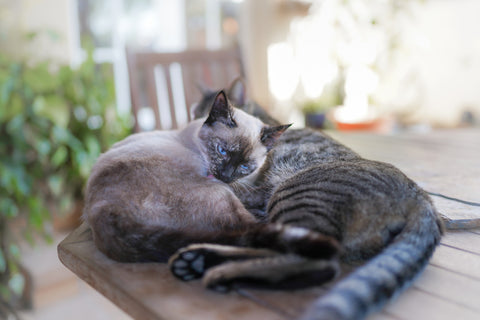
Alpha mannosidosis is a lysosomal storage disorder which results in the decreased efficiency of the production of an enzyme called alpha-D-mannosidase. This enzyme is involved in the digestion of complex sugars derived from glycoproteins. A defective alpha-mannosidase causes progressive accumulation of mannose-rich oligosaccharides in all tissues, which ultimately leads to cell death.
Background information
Mannosidosis is a group term for deficiencies in the enzyme mannosidase. This enzyme is involved in the hydrolysis of the sugar mannose and can be found in two forms: α (alpha) and β (beta). Depending on which of these enzymes is deficient, human mannosidosis is classified as α-mannosidosis or β-mannosidosis (U.S. National Library of Medicine, 2018). In cats, Mannosidosis has been described in a Domestic Shorthair kitten, Persian kittens and Domestic Longhair kittens. Although there is high clinical and pathologic heterogeneity among the disease groups, the feline disorder has been linked to human α-mannosidosis (Cummings et al, 1988). Alpha mannosidosis is a lysosomal storage disorder which results in the deficiency of the production of the enzyme alpha-D-mannosidase. This enzyme is involved in the digestion of complex sugars derived from glycoproteins. A defective alpha-mannosidase causes progressive accumulation of mannose-rich oligosaccharides in all tissues. This disrupts various cellular functions and causes apoptosis, or programmed cell death (Malm & Nilssen, 2008).

Genetics
Deficiency of alpha-mannosidase in cats is associated with an autosomal recessive mutation in the lysosomal alpha-mannosidase gene (LAMAN), although there are confirmations that different mutations may occur in certain cases (Berg et al, 1997). This disorder has been diagnosed in cats of different breeds, including polycats, but it shows high heterogeneity among the groups (mainly domestic shorthairs, longhairs and Persians) and seems to be more progressive in Persian cats than in other breeds(Cummings et al, 1988). The mutation is inherited in an autosomal recessive mode, meaning that a cat must inherit two mutated copies of the gene (alleles), one from each parent, in order to be affected by the disorder. Cats who carry only one mutated allele and one healthy allele remain silent carriers (they can pass on the trait to the offspring but aren't affected themselves). If two silent carriers cross, there is a 25% chance for each kitten to be affected. Two affected cats give only affected offspring.

Symptoms and diagnosis
The clinical presentation is usually onset between the age of 7 to 15 months. Symptoms of Mannosidosis involve ataxia (nerve degeneration), tremors, slowed growth, corneal abnormalities, hepatomegaly (enlarged liver), and calvarial changes. Cases with behavioral symptoms such as disrupted responses, dementia and apathy have been reported, too. In Persian kittens, this deficiency has been associated with stillbirths and neonatal death (Cummings et al, 1988). Diagnosis of alpha-mannosidosis involves the detection of alpha-mannosidase enzyme activity in peripheral blood leukocytes, or white blood cells.
Treatment and prognosis
Long-term effective treatments for alpha-mannosidosis in cats have not been discovered yet. Generally, treatments of single enzyme deficiencies such as this one involve bone marrow transplantations and enzyme replacements. Gene therapy could also be of great interest in therapeutic attempts of addressing this feline disorder. A very promising 2016 study by Yoon et al. tested the efficacy of cisterna magna infusion of adeno-associated virus type 1 (AVV1) expressing a healthy feline alpha-mannosidase gene in the affected cat. Essentially, Yoon and his colleagues injected a virus with the “healthy” allele into several cats’ brains. Their approach was reported as successful and could be an applicable approach to different disorders in the future (Yoon et al, 2016). Note: It is not recommended to breed carriers of Mannosidosis in order to prevent the progression of the condition to the offspring. A genetic test is now available to detect the mutation.

Mannosidosis is a group term for deficiencies in the enzyme mannosidase. Although there is high clinical and pathologic heterogeneity among the disease groups, the feline disorder has been linked to human α-mannosidosis (Cummings et al, 1988). Since long-term effective treatments for alpha-mannosidosis in cats have not been designed yet, it is not recommended to breed from mutation carriers in order to prevent the succession of the genetic anomaly to kittens. New research may be able to bring new treatment options in the future, with gene therapy being the most promising solution.
Citations:
1. Berg T, Tollersrud OK, Walkley S, Siegel D, Nilssen Ø (1997). Purification of feline lysosomal α-mannosidase, determination of its cDNA sequence and identification of a mutation causing α-mannosidosis in Persian cats. Biochem. J. 328:863–870
2. Cummings JF, de Lahunta A, Boeuf LL (1988). The Clinical and Pathologic Heterogeneity of Feline Alpha-Mannosidosis. Journal of Veterinary Internal Medicine 2(4):163-170
3. Malm D, Nilssen Ø (2008). Alpha-mannosidosis. Orphanet J Rare Dis. 3:21. doi: 10.1186/1750-1172-3-21.
4. US National Library of Medicine (2018). Mannosidases. Medical Subject Headings (MeSH) Descriptor Data 2018.
5. Yoon SY, Bagel JH, O'Donnell PA, Vite CH, Wolfe JH (2016). Clinical Improvement of Alpha-mannosidosis Cat Following a Single Cisterna Magna Infusion of AAV1. Molecular Therapy 26(1):26-33 doi



